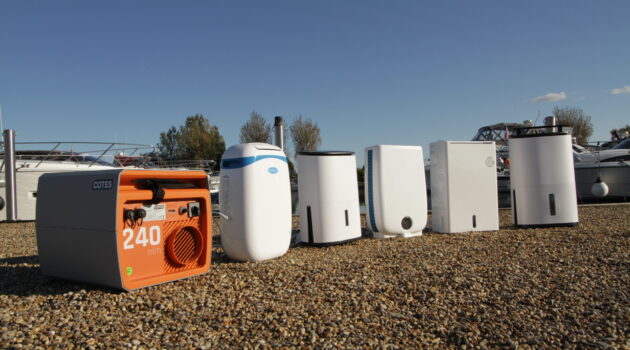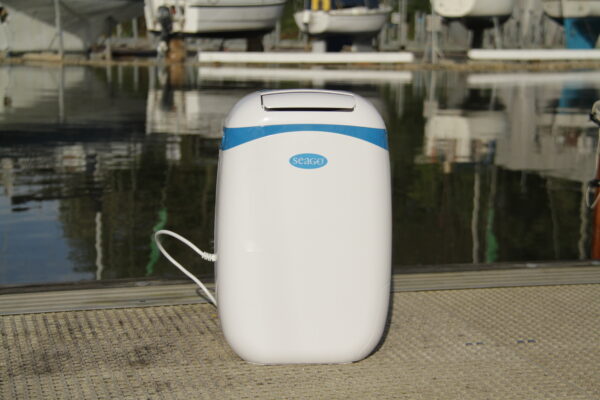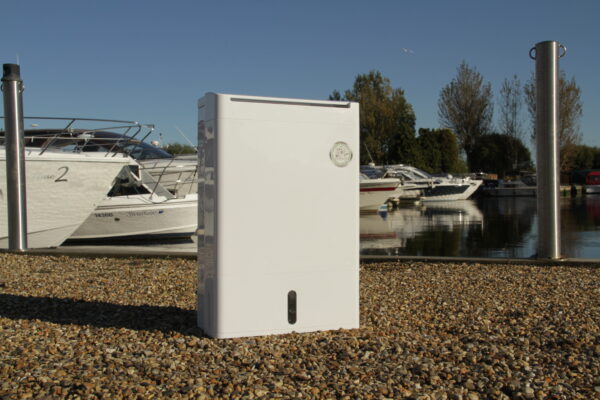Damp and condensation drive me to instant apoplexy! If there's one piece of advice I can give to any boat owner is get yourself a great dehumidifier! Phil Sampson and Tech Editor Jayne Toyne tested some of the best dehumidifiers to help you decide which is best for your usage...
It sounds obvious, but boats tend to live in a damp environment. Even if you keep yours ashore or in your driveway, damp can still be an expensive problem. A good, reliable dehumidifier is an absolute essential piece of kit for pretty much every boat owner that has a boat with enclosed living space.
I own two dehumidifiers and both work flat out from late autumn to mid spring here in the UK and in the Azores where humidity is often around 95%. I also fill my cupboards and wardrobes with non-electric dehumidifiers too.
It doesn’t matter if you live on your boat or not, moisture, even in a boat laid up for winter can be a really expensive and damaging problem.
An added challenge with coastal or ocean going boats is that salt water inevitably finds its way down below. And salt, as we all know, retains/attracts moisture.
The problems caused by damp aren’t limited to mould, mildew and mustiness: electronics, electrics and engines will suffer too, not to mention tools when the humidity rises unchecked.
If you don’t already have a dehumidifier, then what are you waiting for? These things pay for themselves in the reduction of damp induced electrical gremlins and mildewy interiors.
At a glance – our tested models
7 of the best boat dehumidifiers available right now
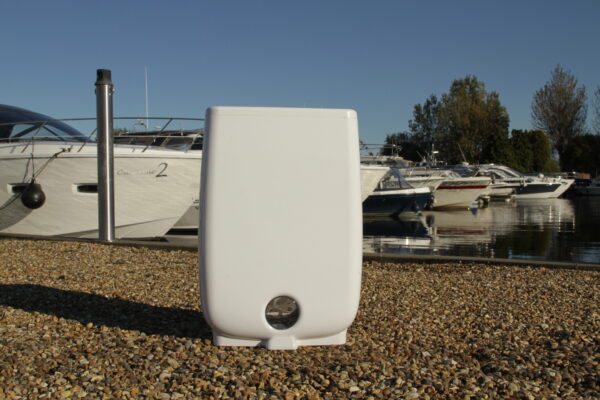
Meaco DD8L Junior
Specifications: Type: Desiccant | Dimensions: 500 x 351 x 188mm | Tank capacity: 2l | Continuous drain facility | Weight: 6.4kg | Power consumption: 330/650W | Drying capacity: 8l/day | Noise level: 48dB
Reasons to Buy: Quiet | Extracts lots of water | Lightweight | Has worked faultlessly for years
Reasons to Avoid: Uses a little more power than a compressor type | Filter housing is a little fiddly
Weighing in at an immensely portable 6.4kg, the DD8L is Meaco’s lightest desiccant dehumidifier. But that doesn’t mean its performance is lightweight – our test unit succeeded in extracting a gallon of water from the atmosphere in just 18 hours, going on to capture a total of 6.1l (1.34g) over the course of our 24-hour trial.
The unit was doing well in terms of reducing the relative humidity (RH) within our test enclosure, taking it from 56% down to 46%, but then the heavens opened and exposed its limit; the RH climbed back up to 66%, only subsiding once the weather improved.
The warm air exiting the machine, which our overhead sensor recorded as reaching 27°C, succeeded in raising and maintaining the overall room temperature above 14°C (peaking at 16.8°C during the warmest part of the day) for the duration of our trial.Despite the plethora of setting possibilities depicted on its control panel, the DD8L is simple enough to use.
The set-and-forget ‘normal’ setting will satisfy the requirements of many boaters. This seeks to achieve a RH value of 50% (which our unit bettered) after which the unit enters a 30-minute cycle where it stops drying the air but leaves the fan running for 10 minutes. After this the fan goes to sleep for half-an-hour before the machine resamples the air and starts operating again should the RH have risen.
A big plus point is that like the other Meaco units we tested the DD8L can be left alone to look after itself 24/7; it automatically restarts if a power outage occurs and has a tilt switch which turns the machine off should it topple over.
The DD8L is also offered in a less expensive format – the DD8L Junior – which is the same unit but without an anti-bacterial coating on the filter or an air-quality improving ioniser.

Ufesa 10L
Specifications: Type: Compressor | Tank capacity: 2l | Continuous drain facility | Weight: 9kg | Power consumption: 120W | Drying capacity: 10l / day | Noise level: 35dB
Reasons to Buy: Compact size | Easy to access and clean filter | Efficient and simple operation
Reasons to Avoid: Noticeable hum | Caster wheels are both a blessing and curse
A compact and lightweight model, the Ufesa will fit into smaller spaces and fit easily on countertops.
The supplied tube will allow you to leave this unit draining into a sink or other drain. This compressor unit is fairly quiet, but in a small space you will hear it working.
It’s efficiency is on par with most other compressor dehumidifiers and after a day switched on, the humidity is noticeably reduced. It doesn’t have the sophistication of some more expensive models, but it gets the job done. It does have a laundry setting too which basically makes the unit work flat out, but it has dried stuff pretty well when laundered and hung to dry nearby.
This unit has been on test for 2 years in a high humidity environment in a boat based in the Azores Islands in mid Atlantic and has performed well. Though it would struggle if the ambient temperature were to drop below 8c, so an additional heater might be required if this is used in a cooler climate. Otherwise, as with all compressor dehumidifiers, you’ll lose some efficiency due to defrost mode.
The little caster wheels are both a blessing and curse. To keep this safe on the counter top, I’ve had to jack it up onto some books to stop it rolling around when the boat rocks during inclement weather on its berth.
I never leave the unit running when I’m away from the boat for longer than a few hours due to the inherent fire risk of compressor type units.
Seago Ecodry
Specifications: Type: Desiccant | Dimensions: 487 x 320 x 200mm | Tank capacity: 2l | Continuous drain facility | Weight: 6kg | Power consumption: 660W | Drying capacity: 7l/day | Noise level: 49dB
Reasons to Buy: Excellent value for money | Easy to use and extremely portable
Reasons to Avoid: Niggly drain hose needs reshaping with hot water
I very much like the small size and light weight of Seago’s Ecodry unit.
The Seago Ecodry is a closely-specced rival to the Meaco DD8L and is equally versatile and simple to use.
One feature the Seago unit has over the DD8L is a louvre that can be set to swing in order to waft the dry air it produces around.
The conditions on the day of my test started wet, dried later, then got damp again overnight. The starting relative humidity (RH) was 76% and the temperature 8.5°C. Within an hour of starting, my overhead sensors measured the air exiting the unit at 40% RH and 16.8°C; the Seago Ecodry was clearly doing its job.
I did have one niggle out of the box as the supplied drain hose was stiff and set in a coil shape, the way it had been shipped. Try as I might, it wouldn’t straighten out and I had to boil the kettle to soften it up. That might not sound a big deal, but on a cold boat in the middle of winter it would bug me – a flexible neoprene tube would be far better.
Then again, Seago competitor Meaco plays the sustainability card here, saying that many hoses never get used so they don’t supply one. You pays your money…
During the day, the temperature steadily rose and remained mild for the duration of the 24-hour test period. While the Ecodry succeeded in lowering the RH to 59%, the persistent overnight damp caused it to rise once more and by the end of our trial the Ecodry was working its socks off to maintain an RH figure in the low 60s.
As witness to how hard the machine was trying, when I came to turn it off at the end of the test, the sensor above the louvre was showing a RH of 32%, the driest output figure we recorded of all the dehumidifiers we tested. It also extracted more water than any other unit; 6.4l, not far from its claimed maximum 7l/day capacity.
Meaco DD8L Zambezi
Specifications: Type: Desiccant | Dimensions: 548 x 358 x 200mm | Tank capacity: 3l | Continuous drain facility | Weight: 7.8kg | Power consumption: 350-660W | Drying capacity: 8.3l/day | Noise level: 50dB
Reasons to Buy: A really versatile workhorse | Well suited for use on medium to larger boats.
Reasons to Avoid: Larger unit might not fit into small spaces
Why Zambezi? Because Meaco supports the David Shepherd Wildlife Foundation which cared for Zambezi, an orphaned elephant, until he lost his life in 2018. Today, the Foundation receives a £2 donation for each DD8L Zambezi unit Meaco sells.
To determine whether the feature-packed Zambezi is the king of the dehumidifier jungle, I ran it at full power for the duration of the 24-hour trial.
Out of the box, the Zambezi is an impressive beast. Smart and solid feeling, it has digital display controlled by a set of up, down, left and right buttons around its on/off/mode confirmation switch. It took me a minute or two to find my way around the options, but once I’d sorted that, everything was straightforward enough. In addition to RH and fan speed, the controls also set the angle of a louvre to direct the output air.
The day of the test was a chill but largely sunny day, with a starting RH of 73% and a temperature of 8.4°C. Within an hour, the Zambezi had reduced the RH by 10 percentage points with the temperature inside the enclosure standing at just 8.8°C – the unit was obviously working hard, with my sensor immediately above the air output registering RH values in the 30s. After six hours the Zambezi had succeeded in meeting its target of 55% RH, by which time the temperature was 17°C.
For the remainder of the trial the Zambezi kept the RH firmly in check, with figures mostly hovering around the 50% mark, although dipping to 47% at one point. The temperature was managed admirably too, reaching a maximum of 18.8°C. Overnight the temperature dipped back a little, but never any lower than 14°C.
A total of 4.2l of water was extracted during the course of our 24 hours trial.
MeacoDry Arete Two 10l
Specifications: Type: compressor | Dimensions: 492 x 319 x 237mm | Tank capacity: 2.5l | Continuous drain facility | Weight: 10.7kg | Power consumption: 152W | Drying capacity 10l/day | Noise level: 35dB
Reasons to Buy: Good for use in a warm humid climate | App control is useful for remote operation
Reasons to Avoid: Less ideal for cold climates
According to the Ancient Greeks, Areta was the goddess of excellence – so I had high hopes for the 10l Arete Two model Meaco kindly loaned me for my trial.
Compared to the Arete One, despite consuming less power the ‘Two’ exhales 50% more air – 152 cubic metres per hour – making it a more efficient option. The problem is it’s a compressor unit so is not well suited to the British climate.
There’s another potential issue with the Arete Two from a boater’s perspective – it’s mounted on castors, not great if your boat is rocked by the tide or passing vessels. While the manual stated the unit is shipped with its castors inside the water tank, mine was not – they were pre-mounted and I could find no easy way to remove them.
On the plus side, the Arete Two is compact unit which can be stood right up against a wall. It also comes with an app which allows you to monitor performance from afar. While the app can also link to a voice assistant (“Alexa, set the Relative Humidity to 55%, then turn off after an hour,” that kind of thing) it can still be operated perfectly easily from its top-mounted control panel.
All that’s needed is a single press of the power button and Arete Two is off and running with its pre-set aim of reducing RH to 55%. The panel also features a progress bar to show how the air is drying out, and the target RH can be altered by way of the unit’s variable humidistat – which is just another button to press.
My trial of the Arete Two was held on a crisp dry day which immediately followed a warm damp one. The RH at the start time was 72% and the temperature 8.6°C, rising to a high of 18.3°C during the day.
Following a short RH spike to 77% the unit soon had the air down to 62%, which was maintained there or thereabouts for the remainder of the test despite the nighttime temperature dropping to 7.6°C. Over our 24-hour test period, the unit extracted 1.6l of water.
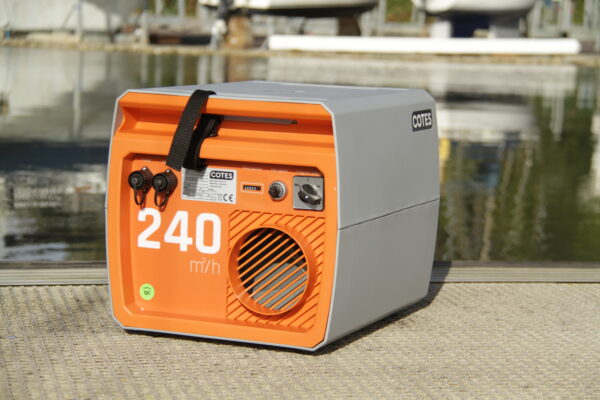
Cotes CR240 Lightweight Dehumidifier
Specifications: Type: Desiccant | Dimensions: 333 x 363 x 400mm | Continuous drain facility only | Weight: 18kg | Power consumption: 1005W | Drying capacity: 19.2l/day | Noise level: 59dB
Reasons to Buy: Suits a larger boat with space to mount this in an engine or facilities bay | Permanent fitment for use alongside other fitted equipment
Reasons to Avoid: The heat is lost outside of the boat | Not very practical for impermanent fitting though this is possible
My final test unit is a dehumidifier unlike all the others, for the Cotes CR240 Lightweight is a commercial unit which Cotes’ distributor Humidity Solutions assures us places it on another level.
Cotes units employ premium components, are European made and purchasers enjoy a system-design service, full parts support and technical assistance should any issues arise. Moreover, as a product intended to be used continuously over the long term without operator interference (the CR240 was originally designed for use in offshore wind turbines) Cotes dehumidifiers have been subjected to a rigorous testing regime and feature built-in overheat protection safeguards.
With customers including Formula 1 teams, satellite manufacturers and Middle Eastern royals (who use them to keep their art collections dry) I was keen to see what the CR240 has to offer.
From the moment I opened its box, the Cotes CR240 shouted quality – it’s rugged enclosure looks and feels the part and its no-nonsense controls are solid and simple to use. As these units were envisaged as permanent fixtures they don’t have water collection containers.
Instead, the damp output air is directed via a flexible hose to a fixed vent, similar to a kitchen extractor, or – as in our case – an attachment designed to be trapped in a window or door frame. While we had reservations about this, we were assured that even if there is a minute air gap as a result of the attachment being jammed into a frame, the CR240 is more than powerful enough to overcome any detrimental effect in terms of damp air ingress.
While the CR240 can be used with an external hygrostat, which switches the unit off when an RH of 50% is achieved, we opted to run our test unit flat out for 24-hours in our enclosure on a damp day where at the start point the RH was registering 77% and the temperature 11.5°C.
Over the course of our trial the unit proved its dehumidifying capabilities – on a day which started damp but turned to dry cold, by the halfway point it had succeeded in reducing the RH to 65%, a value it maintained for the remainder of the trial. However, the external vent served to expel all heat produced by the unit’s desiccant dryer, meaning our enclosure’s ambient temperature dropped from a daytime high of 13.1°C down to 5.2°C overnight.
The external vent also meant we were unable to capture the extracted water, but from our temperature and RH data Coates calculated it had drawn out a shade over 4-litres over the course of our 24-hour trial.
Buy it now from Humidity Solutions
Desiccant or compressor?
Dehumidifiers come in two formats: desiccant and compressor. While the technologies are different, the result is the same; the air coming out of them is dryer and warmer than the air going in. While the Relative Humidity (RH) difference between the incoming and outgoing air will depend on a number of factors, including the RH of the ambient air and how the machine has been set up, the heat generated typically averages 10-12°C for desiccants and 2°C for compressors,
Desiccant dehumidifiers work by drawing in air and passing it through a rotating porous cylinder impregnated with a drying agent (the desiccant; usually zeolite or silica gel) to absorb moisture in the air. The desiccant itself is continually regenerated by a separate stream of heated air which is forced through the cylinder to draw the water out of the desiccant. The resulting stream of warm, damp air is captured, condensed and drained away.
Compressor dehumidifiers are like fridges; they use refrigerant gas to create a cold surface which causes damp air coming into contact with it to condense. This condensation is then drained away and the resulting dryer air recirculated.
As a rule of thumb, desiccant dehumidifiers perform better at low temperatures; Meaco, for example, recommend using desiccant only when the temperature drops below 10°C. For warmer climes, say 15°C and above, compressors can work perfectly well. One point to note though is that while every electrical appliance carries a small risk of fire, compressor dehumidifiers used for long periods at low temperatures have been known to overheat, thereby increasing the risk. Consequently, a number of UK marinas (two examples being Yacht Havens and Parkstone Bay) allow desiccant dehumidifiers only.
Lastly, what about a dehumidifier’s water extraction capabilities? While the numbers look impressive – 8l, 10, 20l per day and so on – those headline figures will only be achieved in very specific, often near-tropical scenarios (Meaco, for example, quote “80% RH and 30°C” is required to draw 20l/day from their Arete Two 20l unit). It’s a little like the fuel figures quoted by car manufacturers, and as our tests reveal real-life operation produces very different results, falling short of the stated maximum in every case. But that doesn’t mean they’re not up to the job; every dehumidifier we test here is suitable for use on a boat, you just need to remember the operating environment will have an impact upon performance when setting your expectations.
Test procedure
To evaluate the test dehumidifiers’ handling of Britain’s ever-changing weather conditions, rather than use the near-sealed confines of a boat, my trials were conducted in a drafty, unheated 40 cubic metre enclosure, which very roughly equates to the interior volume of a 35-40 foot boat. Each unit was placed on a bench 0.75 metres from one end wall with RH and temperature monitors located centrally within the space. A second pair of sensors were suspended 20 cm above each dehumidifier to record the characteristics of the air at the point of output.
Each trial ran for 24-hours. In addition to RH and temperature changes, I also measured the amount of water captured over the period. These metrics, together with energy consumption, warranty and subjective measures of ease-of-use, suitability for boat use and cost form the basis of my reports.
It has to be said I would have preferred to trial a wider range of dehumidifiers, but responses from the manufacturers/distributors of eight other brands I contacted were depressingly non-existent. While that may simply reflect the performance of their marketing departments, to my mind this raises a flag for anybody who may need to communicate with them further down line, perhaps should aftersales service be required.
Relative Humidity – what is it?
RH is a measure of the water vapour present in the air. Expressed as a percentage, the RH value tells you how close to saturation the air is. In general terms, as temperature increases RH decreases, and vice versa. However, other factors can muddy the water by contributing to the equation. For example, as a dehumidifier dries and warms air, the walls enclosing that air will begin to release any moisture trapped within their fabric as the entire space obeys the natural law of equilibrium. In some cases – as we saw with our tests of the Meaco Arete Two units – this can cause an initial spike before the RH settles down and begins to decrease. In fact, the full potential of a dehumidifier will only be realised after several weeks operation when all moisture has finally been drawn from the structure. For that reason, the RH figures achieved in our trials should not be taken as absolute – they are simply records of what we saw at the time of our tests – and there’s no doubt our enclosure was far from bone dry.
Opinions vary as to what the ideal level of RH for comfortable living should be, but a range of 30-65% more or less covers it. Anything much above that will feel damp, while anything below uncomfortably dry.
Money down the drain?
In many cases, running a dehumidifier at full pelt will simply cost you money – it’s not just a matter of how much water is extracted (as explained above that will depend upon the conditions) for if a unit is achieving a steady RH between 30% and 65% it’s doing its job. If your dehumidifier doesn’t have a built-in RH readout, a worthwhile investment is an RH monitor. This will enable you to determine if running your unit at full speed is really necessary, or if a lower fan setting is enough. And with the daily running cost of, for example, the Meaco DD8L ranging from £3.90 at full whack down to £1.98 on low power, the cost of an RH meter could soon be recovered. Finally on the subject of cost, another metric to consider is the cost per litre of water extracted – the results for our test units are given in the table.
What makes the best boat dehumidifier?
Mechanical dehumidifiers that run from a mains supply are often left on the galley worktop to drain into the sink so they don’t cut out when the water bucket fills up. That’s unless you have a top-of-the range boat dehumidifier that’s ‘plumbed in’ and expels water to the outside.
Your first choice is likely to be whether to buy a condenser type of boat dehumidifier or one of the newer desiccant types. The former use a compressor and refrigerant gas to create cold plates or coils on which moisture in the air, drawn in by a fan, condenses before dripping into a bucket.
With the desiccant dehumidifiers, the air passes over a rotating wheel coated with an absorbent material (typically zeolite). The saturated wheel is dried by hot air that’s then cooled so, again, the condensed moisture is collected. This process is more power-hungry, but desiccant dehumidifiers are typically lighter. They also heat the surrounding air and work better at lower temperatures, when condenser types have to shut down periodically to defrost.
Whichever you buy, bear in mind that not all domestic dehumidifiers are designed to be left running for lengthy periods. There have been instances of fires on board being attributed to boat dehumidifiers, so it’s a good idea to check with your insurers just to make sure.
Spec panel
| Meaco DD8L | Meaco DD8L Zambezi | MeacoDry Arete Two 10l | MeacoDry Arete Two 20l | Cotes CR240 Lightweight | Seago Ecodry | |
| Desiccant or compressor | Desiccant | Desiccant | Compressor | Compressor | Desiccant | Desiccant |
| Dimensions (H x W x D) | 500 x 351 x 188mm | 548 x 358 x 200mm | 492 x 319 x 237mm | 618 x 366 x 272mm | 333 x 363 x 400mm | 487 x 320 x 200mm |
| Tank capacity | 2l | 3l | 2.5l | 4.8l | n/a | 2l |
| Continuous drain | Yes | Yes | Yes | Yes | Yes | Yes |
| Net weight | 6.4kg | 7.8kg | 10.7kg | 15.1kg | 18kg | 6kg |
| Power supply | 220-240V | 220-240V | 220-240V | 220-240V | 230V | 220-240V |
| Consumption | 330/650W | 350-660W | 152W | 230W | 1005W | 660W |
| Max extraction rate | 8l/day | 8.3l/day | 10l/day | 20l | 19.2l | 7l/day |
| Max air flow | 115 m³/h | 150 m³/h | 140 m³/h | 255 m³/h | 240 m3/hr | 70 m³/h |
| Operating range | +1 to +37°C | +1 to +37°C | +5 to +35°C | +5 to +35°C | 0 to +40˚C | +1 to +40°C |
| Max sound level | 48dB | 50dB | 35dB | 50dB | 59dB | 49dB |
| Continuous operation | Yes | Yes | Yes | Yes | Yes | Yes |
| Timer | Yes | Yes | Yes | Yes | Yes | Yes |
| Auto restart | Yes | Yes | Yes | Yes | Yes Yes | Yes |
| Tilt switch (turns off unit if knocked over) | Yes | Yes | Yes | Yes | n\a | Yes |
| Standard warranty | Two years | Two years | Five years | Five years | One year | One year |
| Running cost per day at min/max power (based on 25p/kWh) | £1.98 – £3.90 | £2.10 – £3.96 | £0.91 | £1.38 | £6.03 | £3.96 |
| Water extracted during our 24-hour trial | 6.1l | 4.2l | 1.6l | 4.4l | 4.1l | 6.4l |
| Cost per litre of water extracted | 63.9p (at 650W) | 64.9p (at 660W) | 56.8p | 31.3p | £1.47 | 61.8p |
| Recommended retail price | £199.99 | £259.99 | £179.99 | £299.99 | £2,431.00 | £199.95 |




